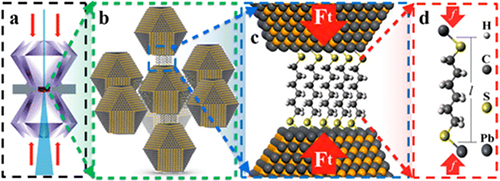X-RAY RUNS: Apply for Beamtime
2017 Nov 1 - Dec 21
2018 Feb 7 - Apr 3
2018 Proposal/BTR deadline: 12/1/17
2018 Apr 11 - Jun 4
2018 Proposal/BTR deadline: 2/1/18
The research work published in the August issue of Nano Letters report the development of the world’s smallest anvil pressure cell, which offers a new experimental platform for investigating the elastic behavior of molecular bundles embedded at nanocrystal interfaces of nanocomposites.
Joint efforts made by scientists across Cornell campus from the Departments of Chemical and Biological Engineering, Material Sciences and Engineering, and the Cornell High Energy Synchrotron Source (CHESS) have resulted to a novel and feasible tool in which a nanocrystal superlattice is used as a nanoscopic pressure cell for in-situ investigation of soft molecules under pressure. Using highly ordered nanocrystal assemblies and exchange of bifunctional molecules at nanocrystal surfaces, the nanometric superlattice cell allows one to study the elastic behaviors of a broad variety of molecular linkers, offering insights into multiple interactions between soft and hard components inside nanocomposites.
The research team, led by Tobias Hanrath at Cornell University, synthesized monodispersive truncated PbS nanocrystals with surface decoration of oleic acid chains. Control of solvent evaporation assembles nanocrystals into periodically ordered superlattice. Enhanced facet-facet coupling of nanocrystals (comparing to the random packed nanocrystals) maximize the magnitude of local alignment of surface molecules between parallel nanocrystal facets. Using the developed ligand-exchanging protocol, the original oleic acid molecules are replayed by length-tunable bifunctional molecules. Unlike oleic acid with one end attaching on nanocrystal surface, bifunctional molecules enable well linkage of the two ends at two nearby nanocrystals, so they act as the basic Hookean springs to control the mechanical behaviors of nanocrystals.
The team, including lead author Kaifu Bian of the Tobias Hanrath group and CHESS scientist Zhongwu Wang, loaded the nanocrystal superlattice into diamond anvil cell (DAC) which transmits the pressure to the nanocrystal superlattice (Figure 1). Thus, they made use of a unique facility at the B1 end station at CHESS to simultaneously collect the small angle and wide angle x-ray scatterings (SAXS and WAXS) from specimens inside tiny DAC. In combination with detailed density functional theory simulations performed by Richard Hennig group at Cornell, the team used the collected SAXS and WAXS patterns of nanocrystal assemblies with various bifunctional linkers upon increasing pressure, and systematically analyzed how soft bifunctional molecules interact with surrounding hard nanocrystals and behave elastically to response the external force loading (Figure 1). With robust datasets of both experiment and simulation, the team demonstrated that the developed method is able to probe the elastic force of single molecule as a function of chain length.

Figure 1. Demonstration of the multiple length scales defining the NC superlattice pressure cell. Millimeter-sized diamond anvils (a) offer external pressure that is transmitted to the PbS NC superlattice (b) that in turn compresses the bundle of molecular chains (c) connecting proximate NC facets. The total force between the NC facets can be described by treating the force of individual molecules as a Hookean spring (d).
The researchers see this methodology as an exciting new opportunity to investigate structure-function relationships of molecules inside nanocrystal assemblies under compression. With understanding the roles of molecules in nanocomposites, the researchers and engineers will be able to find the ways towards directed control and programmable design for future fabrication of bio-inspired advanced materials with enhanced mechanical performance for real world applications.
Reference:
[1] Kaifu Bian, Arunima K. Singh, Richard G. Hennig, Zhongwu Wang and Tobias Hanrath, "The
nanocrystal superlattice pressure cell: A novel approach to study molecular bundles under
uniaxial compression", Nano Letters 14(8), 4763-4766 (2014).
Submitted by: Zhongwu Wang, CHESS, Cornell University
09/04/2014
